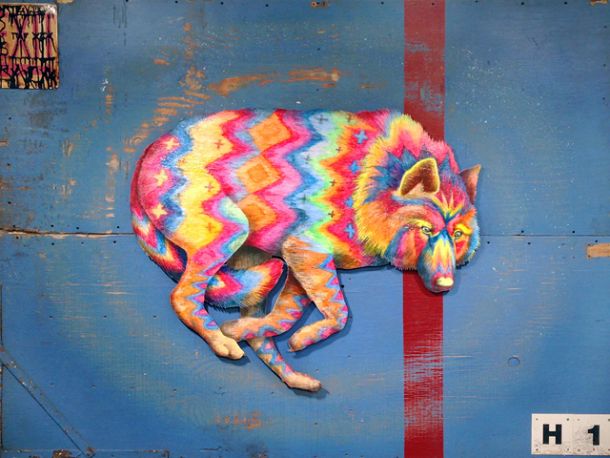Conversation with Artist Jamison Chas Banks
Jamison Chas Banks in his film Cibola.
Jamison Chas Banks born in Kansas, USA, is a dual citizen of the Seneca-Cayuga Tribe, and the Cherokee Tribe of Oklahoma.
"I have been an artist first and foremost since I first started thinking. I am also Native American. I live in this time, not in the past, I cannot make art that seeks to simulate my Native ancestors’ work or designs....I would characterize my work as ‘Attempting to clean an American turkey with a J. Edgar Hoover vacuum cleaner.’ I seek to subvert histories and ‘re-codex’ the American imperial sphere.”-Banks
The work of Jamison Chas Banks incorporates pop culture and indigenous iconography with military and political propaganda. He tackles intense historical tragedy with an urgency and irony that implores the viewer to focus in and think, to look deeper than what was taught, further than what we are told to hold as historical truths. Banks works in all mediums, and seems to use whatever tools necessary to convey his vision, from film to printmaking, from the canvas to massive mural work, there are no limits for this inspiring, activism based indigenous artist.
Here is the conversation with Jamison Chas Banks:
Subscribe to Art Beat Conversations on iTunes and download this episode.
End track featured on this podcast titled 'Fratres for Eight Cellos' by I Fiamminghi & Rudolf Werthen.
Red Scare, Blue Venom. Acrylic serigraph on paper. Edition of 60. Jamison Chas Banks, 2014
More about the Artist:
Artist Jamison Chas Banks takes on symbols and turns them on their heads. He readily admits, “My art incorporates a multitude of symbols. In the end, everything can be maintained as a symbol. I often advance my own imagined personae into representing some other idea or thing, in that, the personae become symbols.” He goes on to assert that “symbols have continued to define and enrich cultures and traditions.” The Cherokee/Seneca artist exudes a certain optimism when he talks about what he perceives as a time of change: “We stand headstrong into a new arena of symbols and mythos, this is a time of renaissance and renewal. It’s safe to assume that Banks is a part of this “renaissance” and that his work is tinged with a subversive hue. He states plainly, with a hint of sarcasm, “I would characterize my work as ‘Attempting to clean a American turkey with a J. Edgar Hoover vacuum cleaner.’ I seek to subvert histories and ‘re-codex’ the American imperial sphere.
Also prevalent in Banks’ work is a military motif that is highly contemporary and relevant--- while acknowledging the tradition and importance of military service that span’s his family’s history. “Most men in my own family, have not only served in the military, but participated during active conflicts,” he explains. Yet, the paradoxical brilliance of his work comes through loud and clear: “patriotic fervor of World War II,” was preceded by harrowing boarding school experiences which literally tore families apart.
When asked specifically what the word “tradition” conjures, Banks says without hesitation, “Tradition is a cycle of behavior or belief built up over generational lengths of time. Tradition can be seen as a colonial term, but so can ‘dog’ and ‘cat’ for that matter. I imagine now anything spoken in English can be seen as a colonial term. It’s a really loaded question because, I think, most art can be defined so differently, depending on who’s defining it. In my experience, there is nothing that can be absolute.”
-Barbara Ellen Sorensen, Tribal College Journal Vol. 25 No. 1 Fall











